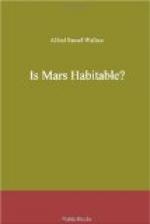“Scattered over the orange-ochre groundwork of the continental regions of the planet, are any number of dark round spots. How many there may be it is not possible to state, as the better the seeing, the more of them there seem to be. In spite, however, of their great number, there is no instance of one unconnected with a canal. What is more, there is apparently none that does not lie at the junction of several canals. Reversely, all the junctions appear to be provided with spots. Plotted upon a globe they and their connecting canals make a most curious network over all the orange-ochre equatorial parts of the planet, a mass of lines and knots, the one marking being as omnipresent as the other.”
Changes of Colour recognised.
During the oppositions of 1892 and 1894 it was fully recognised that a regular course of change occurred dependent upon the succession of the seasons, as had been first suggested by Schiaparelli. As the polar snows melt the adjacent seas appear to overflow and spread out as far as the tropics, and are often seen to assume a distinctly green colour. These remarkable changes and the extraordinary phenomena of perfect straight lines crossing each other over a large portion of the planet’s surface, with the circular spots at their intersections, had such an appearance of artificiality that the idea that they were really ‘canals’ made by intelligent beings for purposes of irrigation, was first hinted at, and then adopted as the only intelligible explanation, by Mr. Lowell and a few other persons. This at once seized upon the public imagination and was spread by the newspapers and magazines over the whole civilised world.
Existence of Seas doubted.
At this time (1894) it began to be doubted whether there were any seas at all on Mars. Professor Pickering thought they were far more limited in size than had been supposed, and even might not exist as true seas. Professor Barnard, with the Lick thirty-six inch telescope, discerned an astonishing wealth of detail on the surface of Mars, so intricate, minute, and abundant, that it baffled all attempts to delineate it; and these peculiarities were seen upon the supposed seas as well as on the land-surfaces. In fact, under the best conditions these ‘seas’ lost all trace of uniformity, their appearance being that of a mountainous country, broken by ridges, rifts, and canyons, seen from a great elevation. As we shall see later on these doubts soon became certainties, and it is now almost universally admitted that Mars possesses no permanent bodies of water.
CHAPTER II.
MR. PERCIVAL LOWELL’S DISCOVERIES AND THEORIES.
The Observatory in Arizona.




